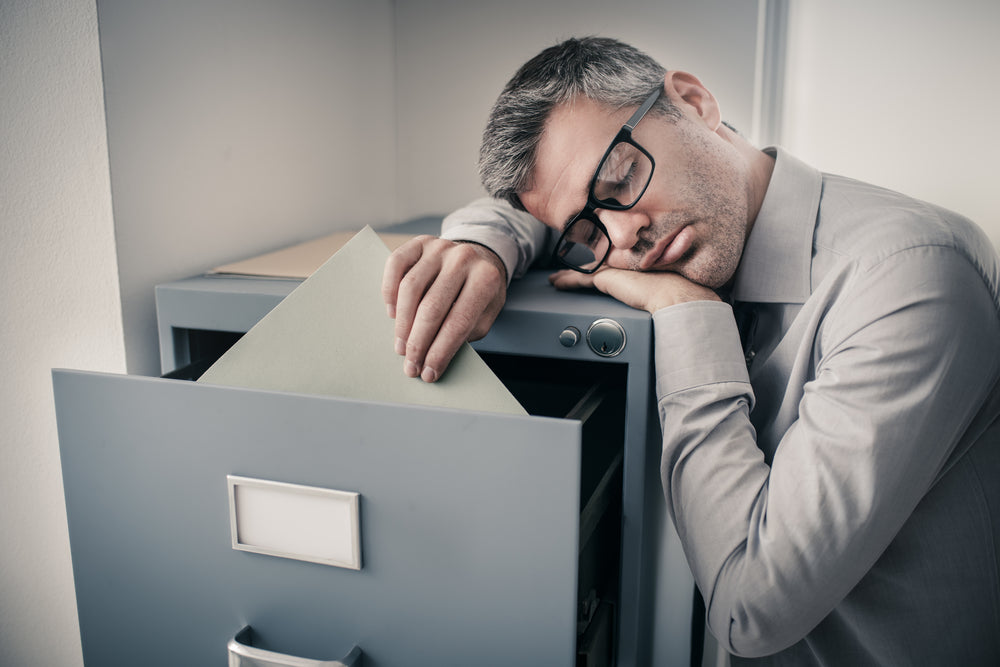Nodding off at work is probably more common than you originally thought—in fact the CDC has gone so far as to call lack of sleep a “nationwide epidemic.” Excessive daytime sleepiness (EDS) has become such a frequent problem for some companies that Virgin Pulse, an organization that researches how to help employees and companies work better, conducted a huge study on exactly how prominent workplace sleeping really is.
The Results:
- 76% of employees felt tired most days of the week
- 40% of employees doze off during the day at least once per month
- 30% of employees were unhappy or very unhappy with the quality and/or quantity of their sleep
- 15% of employees dozed off during the day at least once per week to once per month
The problem of sleep-deprived employees is so overwhelming that some companies estimate a whopping $1,967 annual loss per employee due to excessive daytime sleepiness in the workplace. This loss in productivity is due to the several mental lags that can occur when do you not get the restful, rejuvenative sleep you need to be sharp, aware, and alert while working.
Signs of EDS
While having one bad night is not that much to worry about, frequently feeling tired, unrested, and groggy during the day should alarm you. There are several other signs of EDS that can could be trying to reveal a deeper sleep problem or condition. If you experience any of the following while at work, or just frequently on a day-to-day basis, you should consult your physician soon:
- Can’t shake or overcome brain fog
- Poor or slow decision-making
- Short-term memory problems
- A slump or drop in work productivity
- Nodding off while driving
- Excessive, frequent snoring
- Difficulty falling asleep at night
If you or a co-worker are frequently experiencing these symptoms, there is a significant chance that your excessive daytime drowsiness is due to an untreated medical condition. Other causes for concern are problems staying awake and alert in meetings, during presentations, or even while just sitting at your desk.
Problems Caused by EDS
For one reason or another, at least 20% of the population suffers from excessive daytime sleepiness, and the side effects of this problem reach far beyond the individual. If you are too tired to properly focus, then everyday tasks like driving, parking, walking, and talking are all compromised. Especially with drowsy driving, the ramifications of trying to push through your EDS pose serious safety risks to you and those around you.
In fact, drowsy driving contributes to over 1500 automobile accidents per year, prompting the National Highway Safety Association (NHSA) to dedicate a week to increasing awareness for drowsy driving.
EDS and Medical Disorders
While EDS is not a medical condition in and of itself, it most often points to one. There are many disorders where daytime sleepiness is a factor, but there are a few you should be aware of:
- Hypothyroidism: a condition where the thyroid doesn’t produce enough hormones.
- Restless Leg Syndrome (RLS): a condition characterized by a nearly irresistible urge to move the legs, typically in the evenings.
- Sleepwalking: the act of getting up and walking around while asleep.
- Obstructive Sleep Apnea (OSA): Intermittent airflow blockage during sleep.
Of all of these medical conditions, OSA is most frequently the culprit of excessive daytime and workplace sleepiness. OSA is a condition where the airways get blocked during sleep, causing sufferers to wake up multiple times an hour, even if they don’t realize it. These interruptions pull the body out of the restorative REM, or deep sleep, cycle. A large portion of the population suffers from OSA without knowing it, and an estimated 80% of OSA cases go undiagnosed each year.
OSA has more severe repercussions than just daytime sleepiness. If left untreated for a long period of time, OSA can lead to other medical conditions like Type 2 diabetes, heart disease, high blood pressure, stroke, and even certain types of cancers.
Treating OSA and EDS
If your excessive daytime sleepiness is due to OSA, there is hope for a more restful future. OSA can be easily diagnosed, but you must have a diagnosis from a board-certified sleep physician in order to qualify for treatments.
You can choose between in-lab or at-home sleep studies, but at-home sleep tests are often cheaper, with more comfortable options. Regardless of which route you decide to go, be sure to do your research and ensure you are going with a trustworthy company.
Once you receive your obstructive sleep apnea diagnosis, you can discuss your treatment options with your doctor or a patient care representative. The most effective treatments for OSA are continuous positive airway pressure (CPAP) therapy, automatic positive airway pressure (AutoPAP) therapy, and bilevel positive airway pressure (BiPAP) therapy.
Aside from these, there are other treatments like dental appliances or surgical options that may be available to you depending on the nature and severity of your sleep apnea.
For Employers
Employers are especially impacted by excessive daytime sleepiness in the lost productivity and health of their employees. One way to address this is by choosing to participate in ApneaMed’s partner programs.
These programs allow you to offer OSA in-home testing and treatment options to your employees. By ensuring that your workers are healthy and happy, your company gets better employees who work to ensure your company can succeed in any industry.
If you believe you are suffering from excessive daytime sleepiness and it’s impacting your work or your personal life, be sure to monitor your symptoms and the frequency of your tiredness. If you start to see a pattern or begin to feel worse, be sure to talk to your doctor and see if you should be tested for sleep apnea or other medical conditions.

